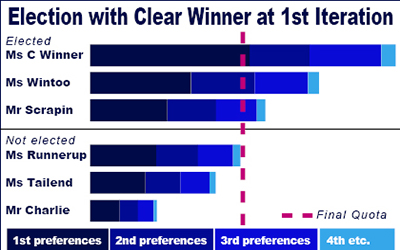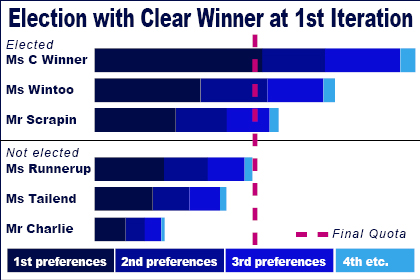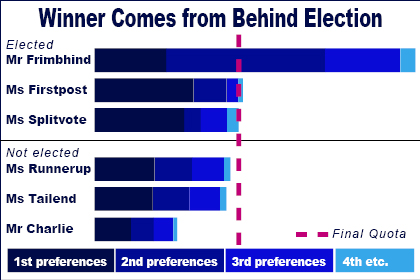Preferential voting better representation of results


Always Ahead: Conceptual bar chart illustrating election in which the most popular candidate was ahead from start to finish.
Trawling through the results of the 2007 local body elections where single transferable voting was used, reveals only discouragingly impenetrable representations of the process involved.
Some results were simply listed as Elected and Not Elected.
Others provided data on numbers of votes and numbers of iterations that I that only vaguely grasped, in spite of being a devotee of single transferable voting.
I wondered what would be against simply displaying preferences in a bar graph?
Although the charts wouldn’t reflect exactly how the count played out, my notion was that the demarcation between those elected and those not, would be broadly apparent.
A explanatory caption could help in a come-from-behind, or other situations, where the outcome was less than self-evident.
Those with a morbid interest in single transferable vote counting could always elect to access greater detail.
Why this focus on local body elections?

From Behind: Conceptual bar chart illustrating election in which the first preferences are split between three successful candidates but one of whom enjoys significantly more subsequent preferences.
When elements within a state take to attacking other (invariably innocent) citizens with explosives, the economic, environmental and social cost of that discontent expodes.
The expensive lesson that was learned, including in the 1970s Baader–Meinhof era, but which seems to go largely unheeded, is that it is more effective to address the causes of disenfranchisement than to command the disaffected to ‘behave’.
A local body structure and electoral system in which only a minority vote, cannot be said to be adequately representative.
Preferential voting may only be a small part of the solution, but it is readily available. The hard work has been done, the legislation is in place—all that remains is for the opportunity to be examined and, hopefully, embraced.
The magnificent ACE Electoral Knowledge Network is a reminder that while some countries, including Aotearoa, are working to improve theirs, others have only recently adopted democratic systems. A number of developing countries, without a history of first-past-the-post, are finding that preferential voting has immediate appeal.
We in Aotearoa accept the arbitrariness of first-past-the-post only because it is what we have always known. We demanded proportional representation but are now disillusioned because of abuses of the spirit of the mixed member system. And single transferable voting gets a bad press thanks to unrelated decisions—the removal of wards in District Health Board elections.
We can fix what ails the mixed member proportional and single transferable vote implementations. It will take quite some mental fortitude, but only a miniscule amount of funding.
The cost of improving our faith in the ballot box is tiny; the events of this week underscore that it is a necessary and strategic long-term investment.
